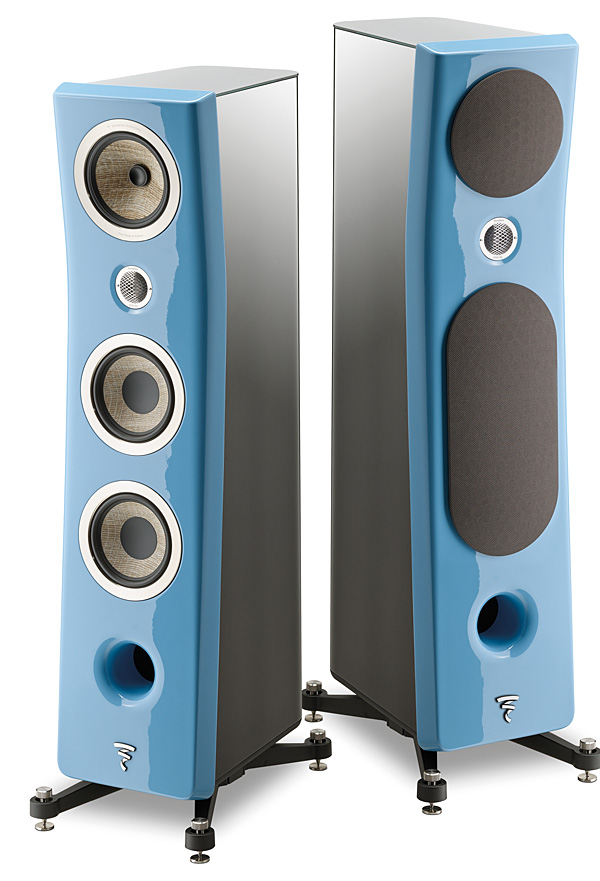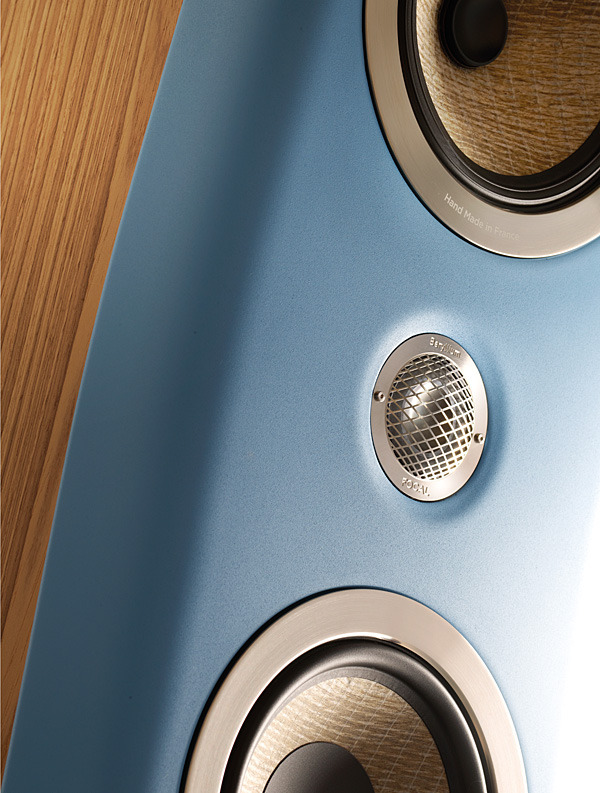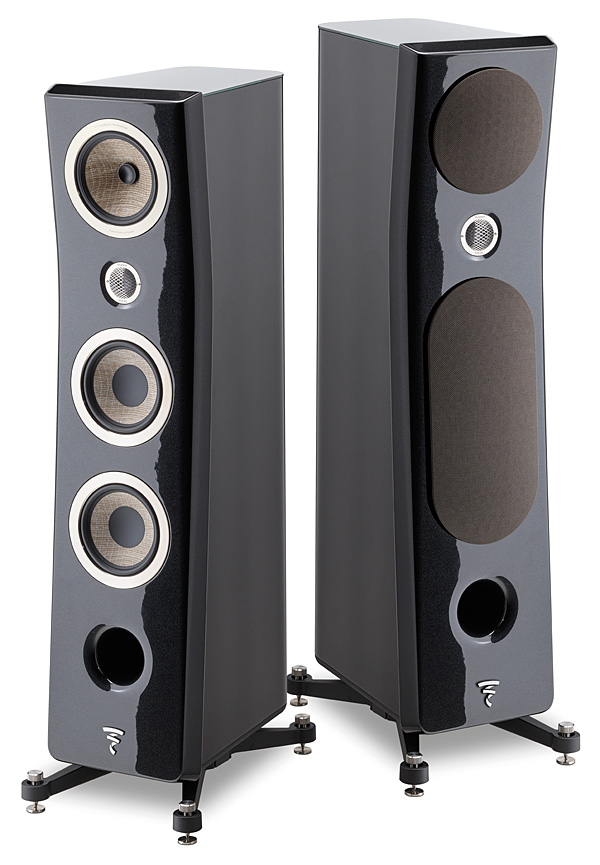| Columns Retired Columns & Blogs |
"Oh Yeah" .............. Yello :-) .............
Over more than two months, I played a variety of CDs and the occasional burn-in CD, trying to pay no attention to any possible changes in sound quality. Then, with no conscious intention to listen critically, I noticed that what I'd first identified as harshness had begun to fade. Eventually, it essentially disappeared, replaced by a pristine clarity. The "exciting" sound that had initially impressed me was still there, the top sounding airy and extended—that beryllium tweeter was earning its keep. When I compared the Kanta No.2s in the same system, at matched levels, with the Monitor Platinum PL300 IIs, the Focals sounded a touch brighter, but by no means excessively so. I prefer the tonal balance of the Monitors, but I know that some people feel that the Platinum PL300 IIs sound a bit too laid-back and polite. As Michael Fremer said a few years ago (footnote 2), "One man's 'bright' is another man's 'fast and clean.' Another man's 'smooth and natural' is another's 'dull.'"

The Kanta No.2 was transparent to the source, adding very little sound of its own. Lately, I've been working my way through the 70 hours of Decca Sound: 55 Great Vocal Recitals (55 CDs, Decca 478 9670)—nice work if you can get it (footnote 3). The compilation features performances by some of the greatest singers of the past century, and the Kanta No.2s let me experience the beauty and power of their voices with few artifacts that I could attribute to the speakers. The reproduction of vocal sibilants presents a definite challenge for any speaker; the Kanta No.2s did an excellent job, sounding neither too spitty nor too soft, and communicating the fine nuances of these performances. They also let me hear the effects of relatively minor changes in my system—eg, updating the PS Audio DirectStream Memory Player's firmware. (PSA continues to extract greater and greater sound quality from the nominally fixed resolution of the Compact Disc.)
Although the two woofers in each Kanta No.2 are relatively small (6.5"), Focal claims that the speaker produces "deep and articulated bass" that extends down to 29Hz, –6dB. The Monitor Platinum PL300 II, with two 8" woofers and a larger cabinet, goes only marginally deeper: to 28Hz, –6dB. John Atkinson's measurements will compare the two speakers' bass performance, but under less controlled conditions in my room, and using bass tests such as Mickey Hart's Planet Drum (CD, Rykodisc RCD 10206) and All Star Percussion Ensemble (CD, Golden Strings GS CD 005), the Kantas' bass performance was surprisingly close to the Monitor Platinums', the latter having a bit more authority at higher levels. Through both pairs of speakers, the synthesizer note at the beginning of "Temple Caves," from Planet Drum, was present as a 32Hz fundamental rather than as mere harmonics of that pitch. The Focals were also adept at communicating the rhythmic quality of the music. And, yes, the Kanta No.2s could play loud—as loud as the music demanded, and as loud as I found comfortable.

The Kanta No.2s precision of aural images was first rate. The last three tower speakers I reviewed—the GoldenEar Technology Triton One, the Wilson Sabrina, and the Monitor Platinum PL300 II—were all excellent in this respect, and the Kanta No.2 was easily in their class. The "Depth of Image: Acoustic Clicker" tracks (34–42) on Best of Chesky Jazz and More Audiophile Tests, Volume 2 (CD, Chesky JD 68) showed clear differentiation of the sound of the clicker at distances from the recording microphone of up to 70'—performance second only to that of the Fujitsu Ten Eclipse TD712z, in my experience.
For most of my listening to the Kanta No.2s I used a pair of PS Audio M700 monoblocks, which I'd found to work well with the Monitor PL300 IIs. When I switched to the McIntosh Laboratory MC275 LE tubed stereo amp (4-ohm terminals), the sound changed in ways that were largely predictable. The MC275 LE is one of my favorite amplifiers, with the easy-on-the-ears quality of tubes at their best, but without an excessively "tubey" sound that becomes a coloration. These characteristics were evident through the Kanta No.2s. The bottom end was not as well defined as with the PS Audios, but the difference was not as great as I might have expected. Dynamics were somewhat subdued with the McIntosh, but this was apparent only in direct comparisons. If I had to choose one of these amplifiers to use with the Kanta No.2s, it would be the Mac—and I'd be quite happy with the PS Audios.
IsoAcoustics Gaias
As mentioned earlier, I had a difficult time deciding whether the Kanta No.2s sounded better with or without their spikes. I'd had a similar dilemma with the Monitor PL300 IIs. In the latter case, the solution was to install a set of IsoAcoustics Gaia I isolation feet. The sound with the Gaia Is installed was clearly better than with the spikes extended or retracted.
I had to try Gaias with the Kanta No.2s. Because each Kanta No.2 weighs only 77 lb to the Monitor Platinum's 120 lb, the recommended foot for the Focal is the Gaia II. IsoAcoustics' Dave Morrison provided me with a set of Gaia IIs, and Daniel Jacques of Audio Plus—US distributor for IsoAcoustics as well as Focal—provided adapters to match the Gaia IIs with the Kanta No.2s' bases.

The results of using the Gaia IIs with the Kanta No.2s were similar to what I'd found with the Monitor Audios on Gaia Is, with perhaps even greater improvements in sound. The bass was tighter and went deeper, and there was greater clarity throughout the midrange. Soundstages were wider and deeper, and images on them were more clearly defined. A set of eight Gaia IIs, four per speaker, costs $599.98, or 6% of the cost of the Kanta No.2s themselves. I'd say it's money well spent.
Conclusions
In their ads, Focal emphasizes the choices of baffle and cabinet finish strongly enough that you might think the Kanta No.2 a "lifestyle" product in which appearance takes precedence over sound quality.
Nothing could be further from the truth. Focal is one of the most technically advanced speaker makers in the world, and the Kanta No.2 has benefited from that expertise, with drive-units designed and made in-house and the applications of other proprietary technologies. After suitable break-in, my review pair of Kanta No.2s was capable of dynamic, well-balanced sound with a high degree of transparency to the source, and surprising bass extension for the speaker's size. Although styling has obviously played a role in its design, there's nothing in the Kanta No.2's sound to suggest that it has resulted in any compromises. With the Kanta No.2, styling is merely the icing on the audiophile cake.
Footnote 3: This set was one of my picks for the 2018 edition of our Records To Die For.

"Oh Yeah" .............. Yello :-) .............

I'll have that corny song in my head for at least the whole day.

Ok, how about "Desire"? .............. Yello :-) ...........

Since you made several comparisons to the larger Monitor Audio PL 300, I wonder, subjectively, how much deeper and/or better the Kanta No3's bass performance is than the Kanta No2. Especially considering there is only a $2k price difference.

I haven’t heard the Kanta No.3, so I can't say how its bass performance compares to that of the No.2. Sorry!
Bob